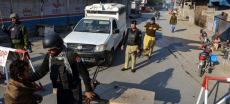[vc_row][vc_column][vc_column_text dp_text_size=”size-4″]Residents of Pakistan’s bustling metropolis, Karachi, experienced the coldest day of the season as the mercury plummeted to a frigid 12°C, dipping below the usual winter norms.
According to the Meteorological Officer’s advisory, the next 24 hours are expected to bring cold and dry weather to Karachi, signaling the arrival of a prolonged spell of chilly days for the city’s inhabitants.
Forecasts indicate that the colder weather will persist over the next 3-4 days, with minimum temperatures hovering around 10°C. This trend is anticipated to continue for the next two to three weeks, making it imperative for locals to prepare for an extended period of winter conditions.
Read more:Additional COVID-19 Cases Detected Among Travelers at Karachi Airport
Current Conditions in Karachi
The latest advisory dispels any hopes of rain in Karachi or other regions of Sindh, emphasizing the continuation of cold weather. The temperature range is projected to fluctuate between 12°C and 20°C, with the maximum UV Index reported as moderate and low visibility observed in the port city.
Air Quality Concerns
While Karachi experiences the winter chill, the air quality in the provincial capital has raised alarms, registering at over 184, categorized as ‘Very Unhealthy.’ Experts warn that the pollution levels have soared to a point where it is deemed unhealthy for sensitive groups. Individuals experiencing symptoms such as difficulty breathing or throat irritation are advised to limit their time spent outdoors.
Weather Across Pakistan
The broader weather outlook for the country indicates predominantly cold and dry conditions, particularly in the northern regions and north Balochistan where very cold temperatures are anticipated. In the plains of Punjab, dense fog and smog are expected to persist, impacting visibility during night hours. Similar conditions are predicted in the plain areas of Khyber-Pakhtunkhwa and upper Sindh, emphasizing the need for caution and adherence to safety measures amid the challenging weather patterns.[/vc_column_text][/vc_column][/vc_row]











